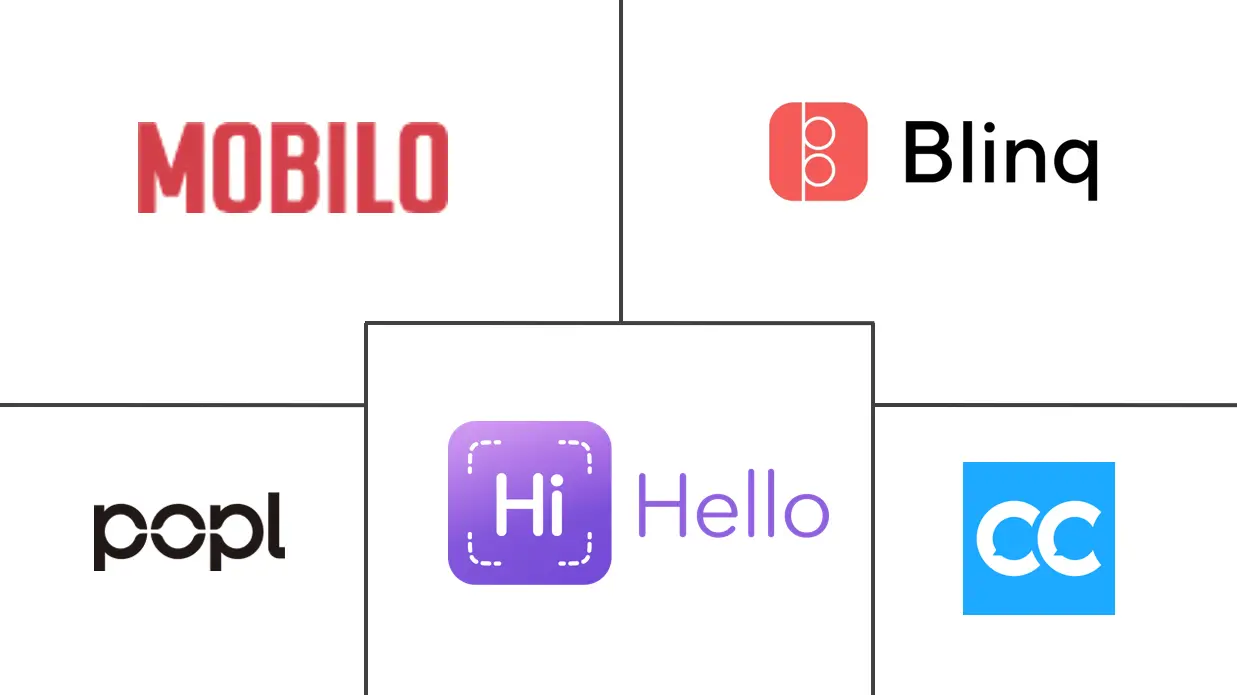Digital Business Card Market Size and Share
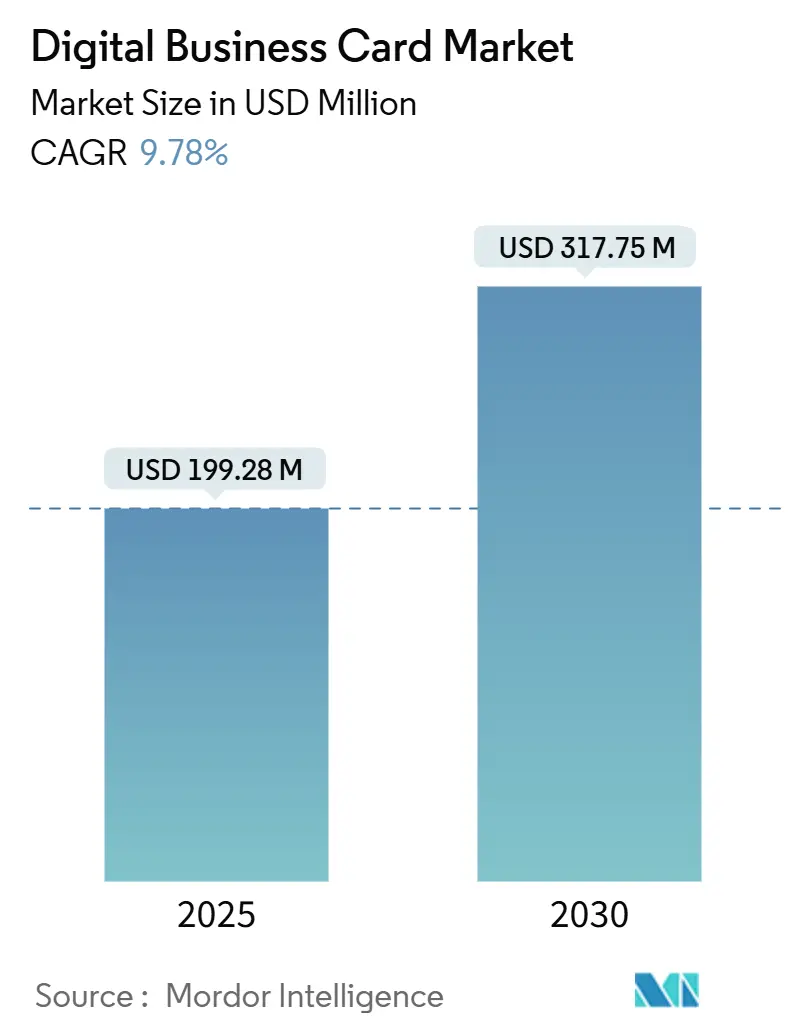
Digital Business Card Market Analysis by Mordor Intelligence
The digital business card market currently generates USD 199.28 million and is forecast to reach USD 317.75 million in 2030, advancing at a 9.78% CAGR. Strong enterprise interest in contact-free networking, lower NFC chipset prices, and the ubiquity of smartphones are shifting budgets away from paper cards toward interoperable, app-light solutions. Platform-agnostic web tools and wallet-native cards appeal to IT departments that need easy provisioning, while Scope-3 reporting pressures prompt corporations to include digital networking in their sustainability road maps. Vendors that embed AI lead-enrichment and CRM connectors are widening the value gap versus basic “static card” apps, encouraging larger deal sizes and multi-year contracts. Heightened data-privacy oversight, however, continues to raise compliance costs for smaller providers that lack dedicated security teams.
Key Report Takeaways
- By platform, Android led with 44.5% revenue share in 2024; Windows/Web is projected to expand at a 14.4% CAGR through 2030.
- By user type, SME business users held 53.8% of the digital business card market share in 2024, while individual professionals are growing fastest at a 16.2% CAGR.
- By pricing model, annual subscriptions accounted for 37.6% of the digital business card market size in 2024; freemium offerings are advancing at a 15.8% CAGR.
- By industry vertical, IT and Software commanded 32.4% of 2024 revenue, whereas healthcare is slated to grow at a 16.8% CAGR to 2030.
- By geography, North America captured 39.3% of 2024 revenue; Asia-Pacific is forecast to climb at a 15.8% CAGR.
Global Digital Business Card Market Trends and Insights
Driver Impact Analyis
| Driver | (~) % Impact on CAGR Forecast | Geographic Relevance | Impact Timeline |
|---|---|---|---|
| Rising demand for contact-free networking | +2.1% | Global (North America and Europe core) | Short term (≤ 2 years) |
| Sustainability and paper-waste reduction mandates | +1.8% | Global (EU and North America lead) | Medium term (2-4 years) |
| Exploding smartphone and mobile-app penetration | +2.3% | Asia-Pacific core, MEA spill-over | Long term (≥ 4 years) |
| Remote and hybrid workforce dynamics | +1.9% | North America and EU, growing in Asia-Pacific | Medium term (2-4 years) |
| Declining NFC chipset and printing costs | +1.2% | Global, manufacturing in Asia-Pacific | Long term (≥ 4 years) |
| Corporate Scope-3 ESG reporting pressures | +0.9% | North America and EU, early Asia-Pacific uptake | Long term (≥ 4 years) |
| Source: Mordor Intelligence | |||
Rising demand for contact-free networking
Seventy percent more professionals now rely on digital exchanges than in 2020 as the habit evolved from pandemic safeguard to standard protocol. Healthcare users in Boston, Baltimore, and Houston share credentials via QR or NFC taps, eliminating physical cards while preserving compliance requirements. Financial centers such as New York, Chicago, and Charlotte mirror the trend, signaling institutional endorsement of always-ready mobile cards. The user experience improves further when wallet-native cards open with a single click, making contact-free sharing the effortless default. As more events deploy “tap to connect” kiosks, the digital business card market gains recurring exposure to first-time users.
Sustainability and paper-waste reduction mandates
Roughly 8 billion paper cards are discarded every year; switching to digital alternatives saves close to 7 million trees annually. EU corporations formalize such reductions in Scope-3 reports, creating an auditable metric for ESG scorecards. Switzerland’s revised Federal Data Protection Act and the UK Digital Markets, Competition and Consumers Act 2024 both promote greener digital workflows [1]International Comparative Legal Guides, “Data Protection Laws and Regulations Switzerland 2024,” iclg.com. Enterprises now issue wallet cards in bulk, cutting print runs and transport emissions. Sustainability teams, once peripheral to networking decisions, now influence procurement, accelerating enterprise-wide rollouts.
Exploding smartphone and mobile-app penetration
Android’s open NFC stack and the rapid uptake of tap-to-pay in Southeast Asia give developers a permissive environment to bundle digital cards inside everyday mobile wallets [2]Consumer Financial Protection Bureau, “Big Tech Companies Restrict Competition in Tap-to-Pay,” consumerfinance.gov. The Consumer Financial Protection Bureau forecasts 150% growth in tap-to-pay transactions by 2028, suggesting soaring comfort with proximate data exchange. As telecom operators subsidize 5G devices, even micro-enterprises in emerging markets gain hardware capable of instant sharing. The momentum elevates the digital business card market beyond urban hubs into second-tier cities where smartphone adoption outruns PC ownership.
Remote and hybrid workforce dynamics
Distributed teams rarely occupy the same physical space, turning printed cards into redundant costs. Employers, therefore, supply staff with managed digital identities that sync directly into CRM instances, closing the gap between first contact and follow-up. Lead analytics dashboards show 35% higher conversion when prospects scan a QR link versus entering details manually. Freelancers in Orlando, Phoenix, and Denver testify to 75% better contact retention when clients can save profiles straight into phone books. Hybrid work thus cements recurring demand for cloud-managed card seats.
Restraint Impact Analysis
| Restraint | (~) % Impact on CAGR Forecast | Geographic Relevance | Impact Timeline |
|---|---|---|---|
| Data-privacy and cyber-security concerns | -1.4% | Global (EU and North America highest) | Short term (≤ 2 years) |
| Limited awareness among micro-enterprises | -0.8% | Global, emerging markets focus | Medium term (2-4 years) |
| Tightening ad-tracking / consent rules | -0.6% | EU and North America, spreading | Long term (≥ 4 years) |
| “App-fatigue” and user-permission hurdles | -0.7% | Global, developed markets core | Short term (≤ 2 years) |
| Source: Mordor Intelligence | |||
Data-privacy and cyber-security concerns
UK updates to the Computer Misuse Act and its Cyber Assessment Framework require stricter audit trails, adding overhead for smaller providers. Switzerland’s GDPR-aligned law raises breach penalties, pushing encryption and regional hosting to the top of RFP checklists. Healthcare and banking buyers demand SOC 2 reports before signing, straining start-ups that operate on thinner margins. Where compliance lag persists, procurement teams default to incumbent vendors with larger security budgets, slowing market entry for newcomers.
Limited awareness among micro-enterprises
OECD studies show that smaller firms often lack the digital diagnostics to judge ROI for new tools. In rural markets where network events are infrequent, owners still see printed cards as “good enough.” Vendors that rely on self-serve onboarding struggle to articulate value in plain language, leaving millions of potential seats untouched. Bridging the gap requires localized training and reseller programs, investments many providers postpone in favor of enterprise pipelines, tempering overall adoption velocity.
Segment Analysis
By Platform: Web-based momentum challenges Android’s lead
Android commanded 44.5% of 2024 revenue thanks to its open NFC APIs and 3.5 billion-unit installed base, anchoring the digital business card market in regions where cost-effective devices dominate. Web dashboards, however, are growing at a 14.4% CAGR as enterprises prioritize browser-only rollouts that work on any OS and skip app-store governance. Windows laptops and Chromebooks thus gain parity with phones, a shift that positions platform-agnostic vendors to court IT departments seeking single-sign-on control. Visa’s “Tap to Everything” credential strategy, which turns any NFC form factor into an identity token, further validates the web-centric path. The digital business card market size attributed to browser clients is on pace to match native-app counterparts within the decade. Vendors that maintain real-time sync across Android, iOS, and browser modes can preserve loyalty as users hop devices.
Despite NFC restrictions, iOS users remain influential in corporate contexts, so providers now embed Apple Wallet passes that open via double-click shortcuts. Where Android still excels is QR auto-launch: the camera app natively decodes a link without third-party permission, cutting one step from the share flow. The coexistence of these design paradigms pushes roadmap teams to adopt modular frameworks—a hedge that limits technical debt when OS policies evolve.

Note: Segment shares of all individual segments available upon report purchase
By User Type: Individual professionals accelerate adoption curve
SME business Users owned 53.8% of revenue in 2024, a legacy of print cost-savings and the appeal of CRM connectors packaged at mid-tier prices. Their bulk purchasing yields predictable renewal income, anchoring the digital business card market size at the core of vendor forecasts. Yet individual professionals—from UX consultants in Austin to real-estate brokers in Miami—are onboarding at a 16.2% CAGR. Their willingness to personalize profiles with video intros and portfolio links creates upsell runway for creative-oriented templates.
These users often discover the product in peer groups rather than company mandates, making freemium entry vital. Once embedded in personal branding routines, churn falls because contacts auto-update when users revise phone numbers, a feature printed cards cannot match. Vendors that automate vanity-URL redirects and analytics unlock incremental revenue despite low ticket sizes. Corporate teams observe this grassroots spread and sometimes standardize tools retroactively, turning bottom-up momentum into enterprise deals.
By Pricing Model: Freemium rise reshapes revenue mix
Annual licences contributed 37.6% of 2024 revenue; CFOs favor them because predictable spend aligns with subscription accounting rules. As security add-ons and multi-brand portfolios deepen functionality, renewal rates remain high. Freemium, however, is climbing 15.8% per year as growth-stage platforms trade short-term margin for reach. They gate AI insight modules and bulk export behind paywalls, nudging power users toward premium tiers while leaving core sharing free.
The tactic expands the addressable base in price-sensitive markets, yet forces continuous A/B testing to balance feature generosity against upsell potency. One-time purchase models survive mainly among solopreneurs who value offline vCard files and resist recurring fees. Monthly subscriptions sit mid-spectrum, appealing to agencies that onboard seasonal contractors for client projects. The coexistence of these schemes keeps average revenue per user flat, but pipeline velocity high.
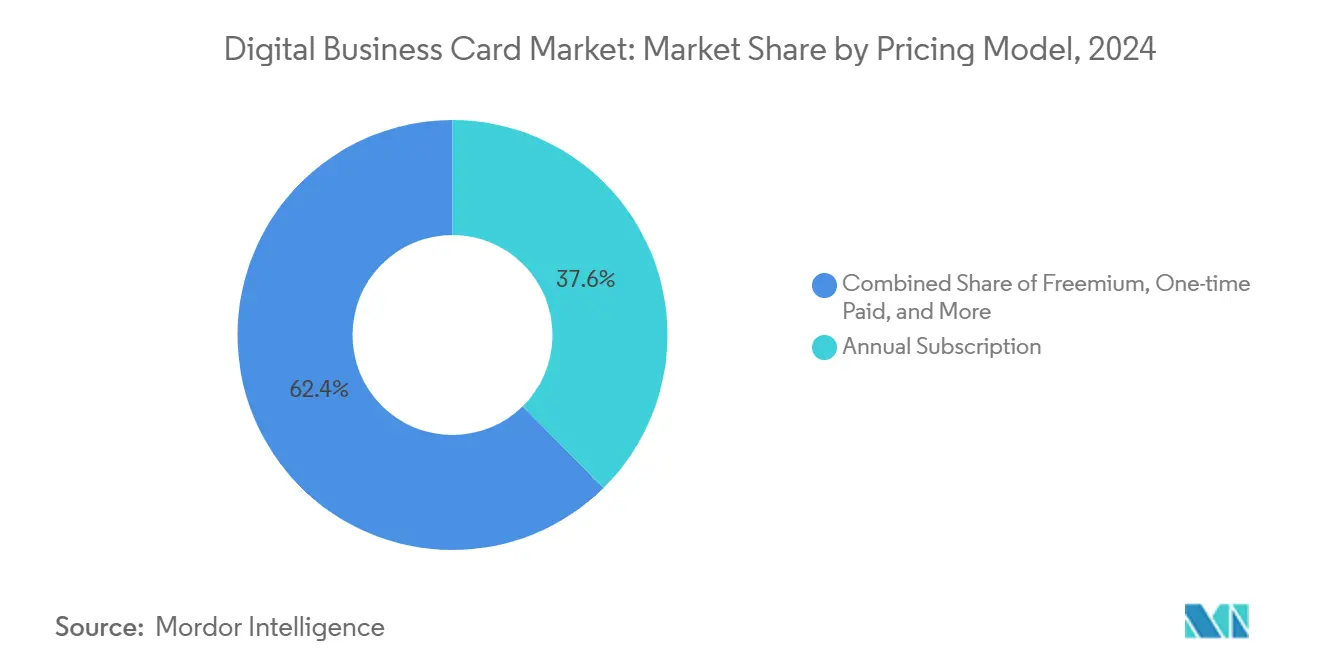
Note: Segment shares of all individual segments available upon report purchase
By Industry Vertical: Healthcare outpaces long-standing IT leadership
IT and Software retained 32.4% share in 2024; their API-literate teams quickly integrated card data into DevOps and sales stacks. Marketing agencies follow closely, embedding UTM parameters in QR links for campaign attribution. Banking, insurance, and advisory firms lift adoption on security grounds, replacing email signature images with live contact widgets that auto-refresh credentials.
Healthcare is sprinting ahead at a 16.8% CAGR. Tele-medicine clinics embed board certifications and HIPAA-compliant channels directly inside shared profiles, cutting onboarding admin for cross-hospital consultations. Surgeons in Houston and nurses in Boston appreciate that credentials update centrally when licences renew, reducing duplicate paperwork. Education is a rising niche: professors swap wallet passes at conferences, logging interactions directly into research networks. The broadening of vertical demand ensures the digital business card market will not plateau after technology early adopters saturate.
Geography Analysis
North America held 39.3% of 2024 revenue on the back of early SaaS penetration and strict documentation norms that make auditable networking attractive. Silicon Valley start-ups were first movers, but financial districts in New York and insurance corridors in Charlotte now treat tap-to-connect as table stakes. Federal procurement guidelines that weigh ESG factors further incentivize agencies to abandon print runs. Larger city-wide events deploy NFC kiosks to expedite badge exchange, offering free exposure for participating card vendors.
Asia-Pacific is expanding at a 15.8% CAGR, lifting the regional digital business card market size faster than any other area. Japan typifies the trajectory: Sansan commands 84.1% domestic share and generated USD 200.8 million in FY2024 Q3 revenue, proving that focused localization can yield dominant economics [3]Sansan Inc., “FY2024 Q3 Financial Results,” sansan.com. Southeast Asia’s deft adoption of super-apps means users treat business cards as another wallet feature alongside ride-hailing and payments. Telecom subsidies for 5G handsets are lowering device entry costs, opening rural professional segments once unreachable by PC-centric tools.
Europe sits between these poles. GDPR alignment favors auditable digital trails, but varying language norms require extensive localization that slows uniform uptake. Switzerland’s data-protection reforms and EU green deals both nudge enterprises toward paperless options. Northern economies with robust cybersecurity legislation pose higher compliance costs, deterring smaller global entrants yet rewarding platforms that certify quickly. South America, the Middle East, and Africa contribute a modest share today; infrastructure gaps and subdued digital literacy curb short-term growth, though double-digit smartphone adoption points to long-run potential.
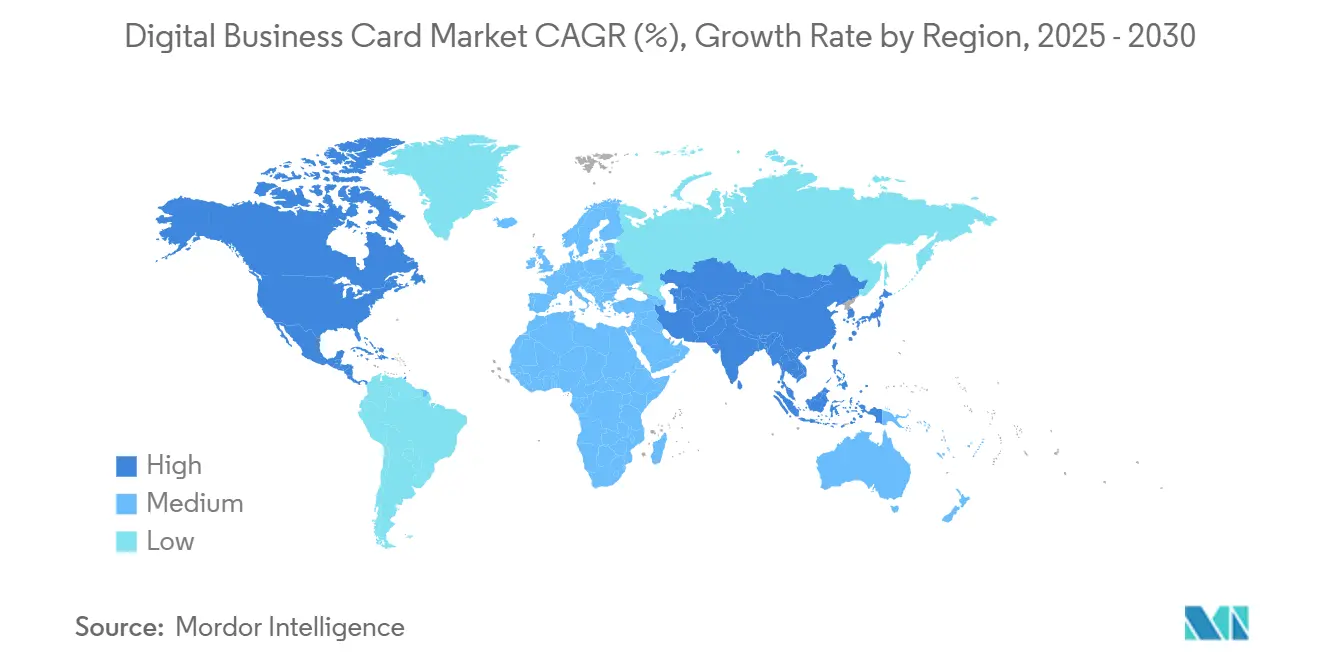
Competitive Landscape
Regional concentration diverges sharply. Sansan owns more than four-fifths of Japan, an outlier compared with the fragmented United States, where the top five players combined hold below 40%. Venture backing remains vibrant: 43 companies have raised USD 193 million since 2020, financing AI enrichment, identity verification, and analytics upgrades. HiHello, Popl, and Mobilo exemplify the freemium-to-subscription staircase, showcasing 20-plus template libraries to lure creative users.
Feature arms races now center on lead intelligence. Providers scrape public LinkedIn data or integrate with Clearbit to auto-fill prospect details, shortening sales cycles. Visa’s credential APIs extend platform reach into hardware categories such as wearables, hinting at physical-digital hybrids. Incumbent firms respond by securing SOC 2 Type II badges and zero-knowledge encryption to retain compliance-minded clients.
White-space strategies focus on vertical specialization. BrandQuantum tailors wallet cards to email-signature flows, useful for regulated financial brands. Healthcare-first entrants pitch HIPAA dashboards and audit logs. Geographic adjacency also drives expansion: Australian players court ASEAN markets with English-language assets, while German vendors bundle eIDAS digital-signature modules. Competitive differentiation thus weaves together security reputation, AI capabilities, and regional empathy.
Digital Business Card Industry Leaders
-
HiHello, Inc.
-
Mobilo Inc.
-
Blinq Technologies Pty Ltd.
-
CamCard (IntSig Information Co., Ltd.)
-
Popl Inc.
- *Disclaimer: Major Players sorted in no particular order
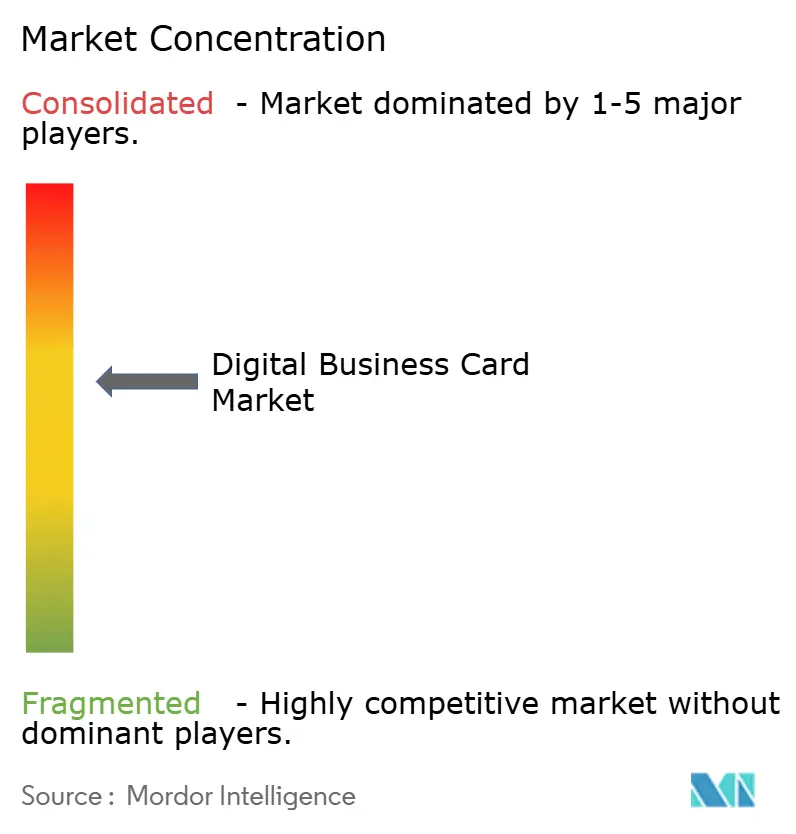
Recent Industry Developments
- June 2025: Cardy launched a wallet-native digital business card that shares via tap, QR, or link, eliminating separate app downloads.
- May 2025: BrandQuantum introduced Google Wallet cards for BrandMail, extending its Apple Wallet feature set to Android users.
- May 2025: HiHello published 2025 platform rankings, naming itself top choice for customization and networking analytics.
- August 2024: HDFC Bank rolled out PIXEL, a full-stack mobile digital credit card, marking its shift toward native-digital financial services.
Research Methodology Framework and Report Scope
Market Definitions and Key Coverage
Our study defines the digital business card market as all subscription-based and one-time fee services that let users create, store, and exchange contact profiles on smartphones, wearables, or web portals; the valuation is expressed in USD revenue generated by software licenses, in-app purchases, and associated cloud hosting. We also trace platform, user type, pricing model, vertical, and regional patterns so decision-makers see the full revenue canvas we analyze.
Scope exclusion: this assessment leaves out standalone NFC tags, printable QR kits sold without a linked software account, and any physical paper card services.
Segmentation Overview
- By Platform
- Android
- iOS
- Windows/Web
- By User Type
- Individual Professionals
- SME Business Users
- Large-Enterprise Users
- By Pricing Model
- Freemium
- One-time Paid
- Monthly Subscription
- Annual Subscription
- By Industry Vertical
- IT and Software
- Marketing and Media
- BFSI
- Healthcare
- Education
- Others
- By Geography
- North America
- United States
- Canada
- Mexico
- South America
- Brazil
- Argentina
- Rest of South America
- Europe
- Germany
- United Kingdom
- France
- Italy
- Spain
- Russia
- Rest of Europe
- Asia-Pacific
- China
- Japan
- India
- South Korea
- Australia and New Zealand
- Rest of Asia-Pacific
- Middle East and Africa
- Middle East
- Saudi Arabia
- UAE
- Turkey
- Rest of Middle East
- Africa
- South Africa
- Nigeria
- Kenya
- Rest of Africa
- Middle East
- North America
Detailed Research Methodology and Data Validation
Primary Research
Mordor analysts interviewed SaaS founders, independent sales consultants, HR onboarding leads, and IT buyers across North America, Europe, and Asia-Pacific. These conversations, along with short online surveys sent to micro-entrepreneurs and marketing agencies, filled data gaps on churn rates, average selling prices, and feature tier migration that raw desk work rarely reveals.
Desk Research
We started with publicly available datasets such as GSMA mobile subscriber counts, World Bank SME registries, and regional ICT adoption indices, which anchor user pools and spending potential. Trade association briefs from the Interactive Advertising Bureau, App Annie trend dashboards, and patent filings on digital identity sharing gave additional technology diffusion clues that shaped adoption curves. Our team then tapped paid repositories, D&B Hoovers for company financial splits, Dow Jones Factiva for funding rounds, and Questel for innovation density, to sense check revenue plausibility against corporate disclosures. This mix of open and licensed sources creates a dependable factual spine; many more minor sources were also reviewed for validation and clarification.
Market-Sizing & Forecasting
The core model uses a top-down 'active user wallet' build, starting with smartphone workforce counts, applying region-wise penetration of digital cards, and layering calibrated average revenue per active profile. Select bottom-up checks, like sampled vendor revenue roll-ups and channel ASP × volume math, calibrate totals before final lock. Key variables include smartphone penetration growth, remote work prevalence, subscription renewal rates, freemium to paid conversion, and regional pricing ladders. A multivariate regression, combined with scenario analysis for data privacy regulation shifts, projects value through 2030; user-validated assumptions guard against optimism bias.
Data Validation & Update Cycle
Outputs pass three filters: automated anomaly scans, peer review by a senior analyst, and a reconciliation against recent funding news or M&A signals. The model refreshes every twelve months, with mid-cycle tweaks triggered by material events, ensuring clients always receive our most current view.
Why Our Digital Business Card Baseline Commands Reliability
Published numbers often diverge because firms pick different scopes, inflate adjacent hardware sales, or freeze currency at outdated rates. We clarify scope at the outset, normalize pricing tiers, and refresh annually, so our 2025 value of USD 199.28 million reflects today's market reality.
Benchmark comparison
| Market Size | Anonymized source | Primary gap driver |
|---|---|---|
| USD 199.28 Million (2025) | Mordor Intelligence | - |
| USD 215.13 Million (2025) | Global Consultancy A | Excludes freemium micro transactions and lacks pricing band normalization |
| USD 350.00 Million (2024) | Industry Association B | Adds NFC tag and print kit revenue, inflating addressable pool |
| USD 178.50 Million (2024) | Regional Consultancy C | Projects straight-line app downloads, omitting churn adjustments |
The comparison shows that scope creep, unvetted multipliers, or static growth lines can sway figures markedly; by contrast, Mordor's disciplined variable selection and cross-checks deliver a balanced, transparent baseline clients can replicate and trust.
Key Questions Answered in the Report
What is the current size of the digital business card market?
The market is valued at USD 199.28 million in 2025 and is projected to reach USD 317.75 million by 2030.
How do freemium models affect vendor growth?
Freemium tiers expand user bases cheaply; AI and analytics upsells then convert power users, underpinning a 15.8% CAGR for the model.
What are the principal restraints to market expansion?
Heightened data-privacy mandates and limited awareness among micro-enterprises reduce CAGR by 1.4% and 0.8%, respectively.
Which platform leads the digital business card market?
Android leads with a 44.5% revenue share, while web-based solutions are the fastest-growing at a 14.4% CAGR.
Why are healthcare organizations adopting digital business cards quickly?
Tele-medicine workflows, credential management needs, and audit-trail requirements drive a 16.8% CAGR within healthcare.
Which region is expected to grow fastest through 2030?
Asia-Pacific, propelled by smartphone ubiquity and wallet-native solutions, is forecast to expand at a 15.8% CAGR.
Page last updated on:
